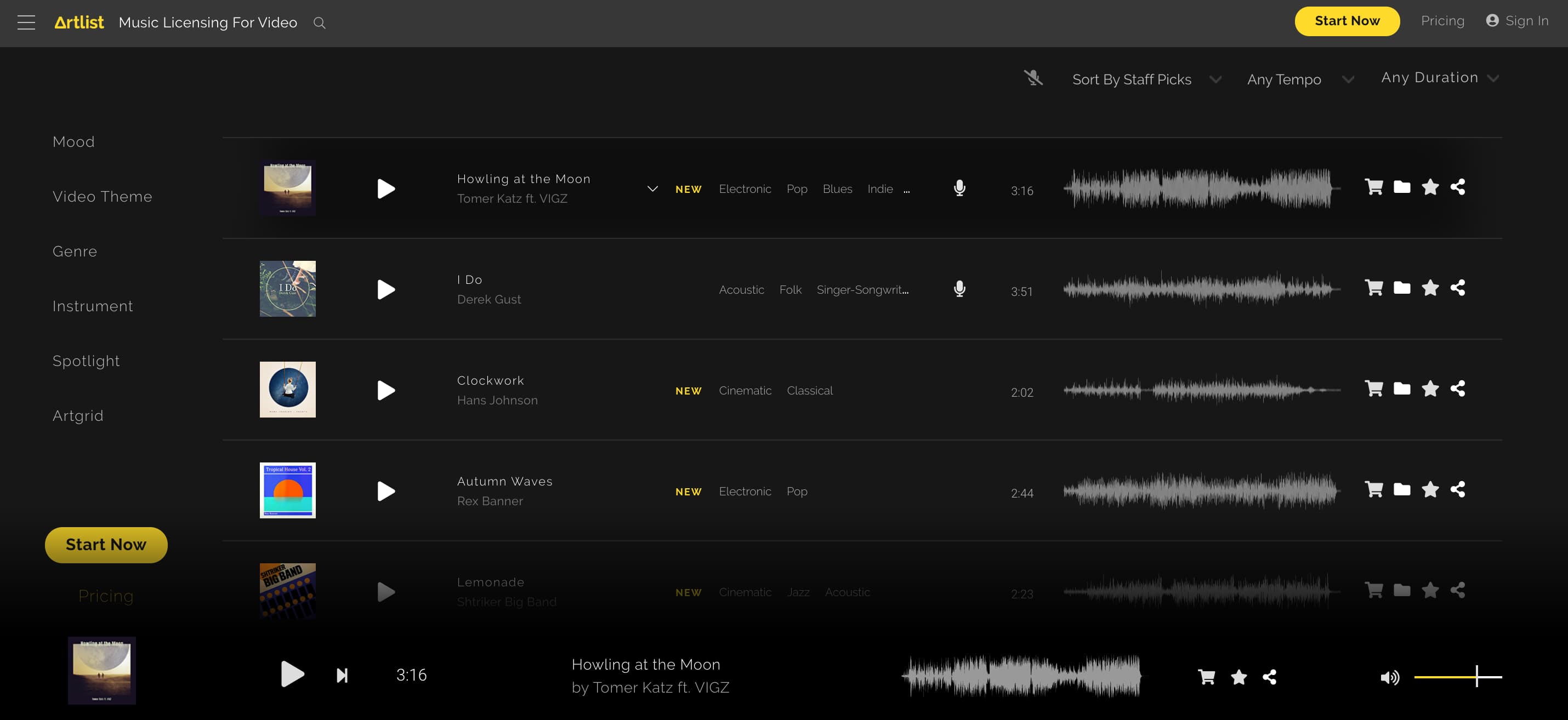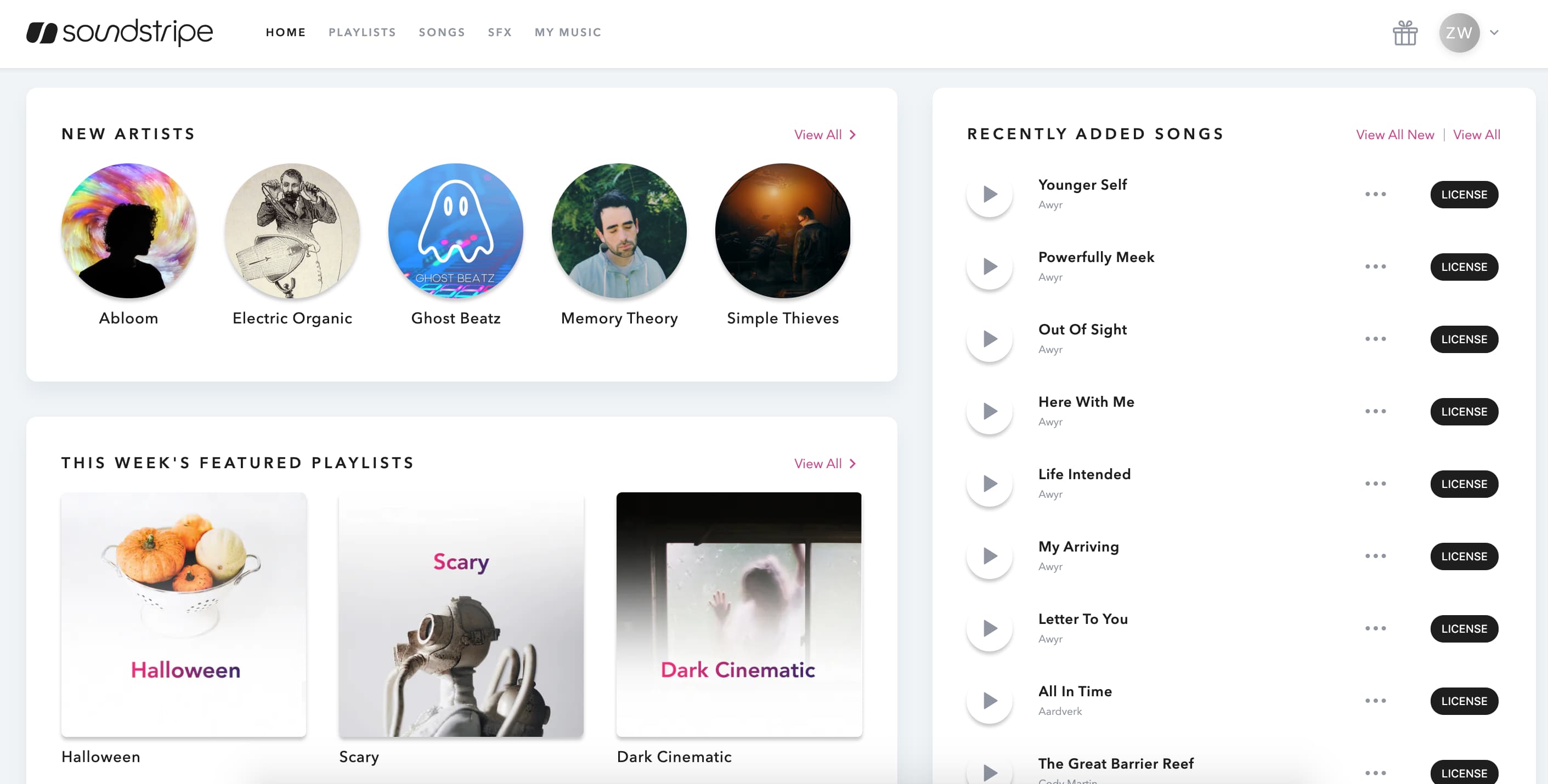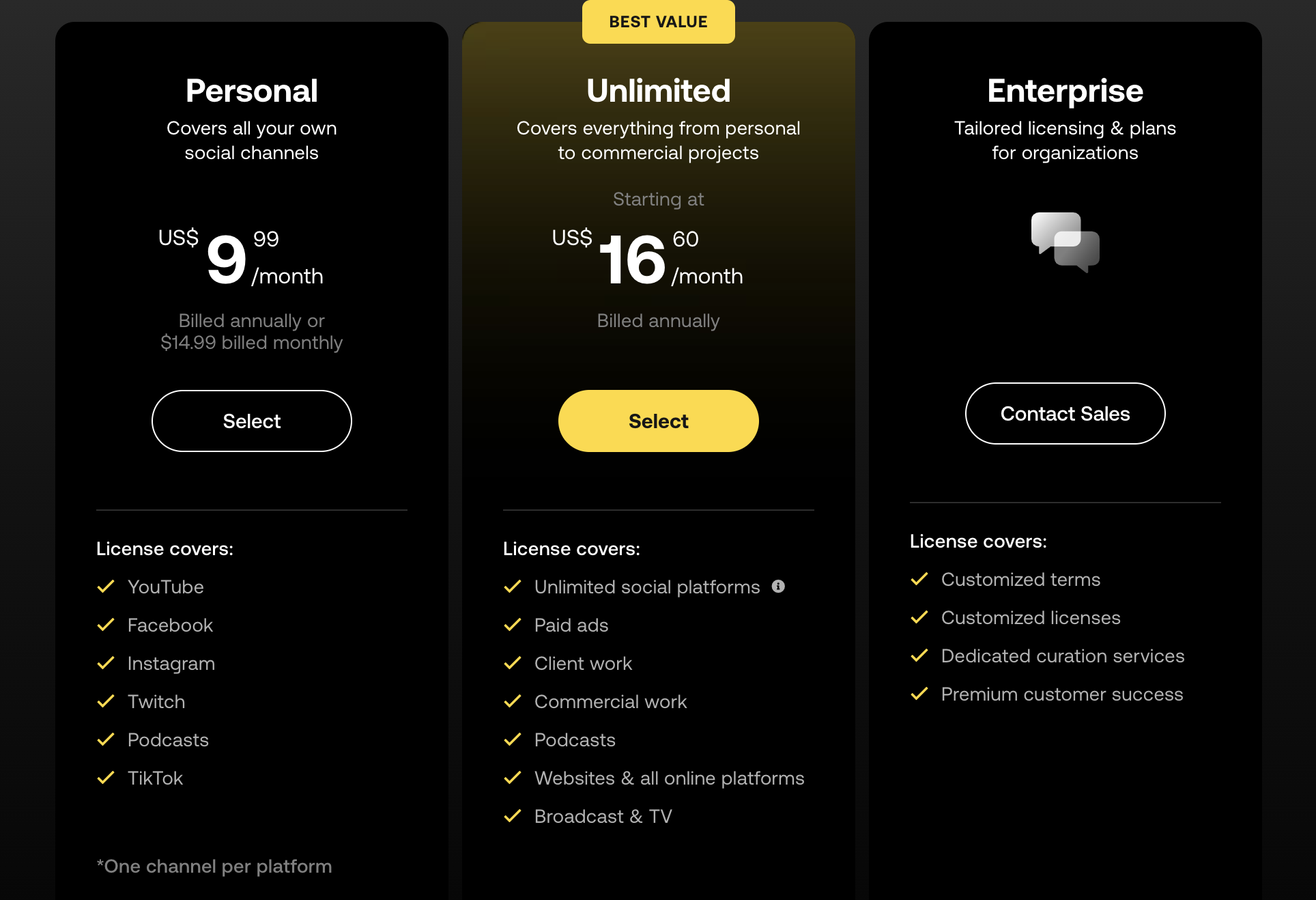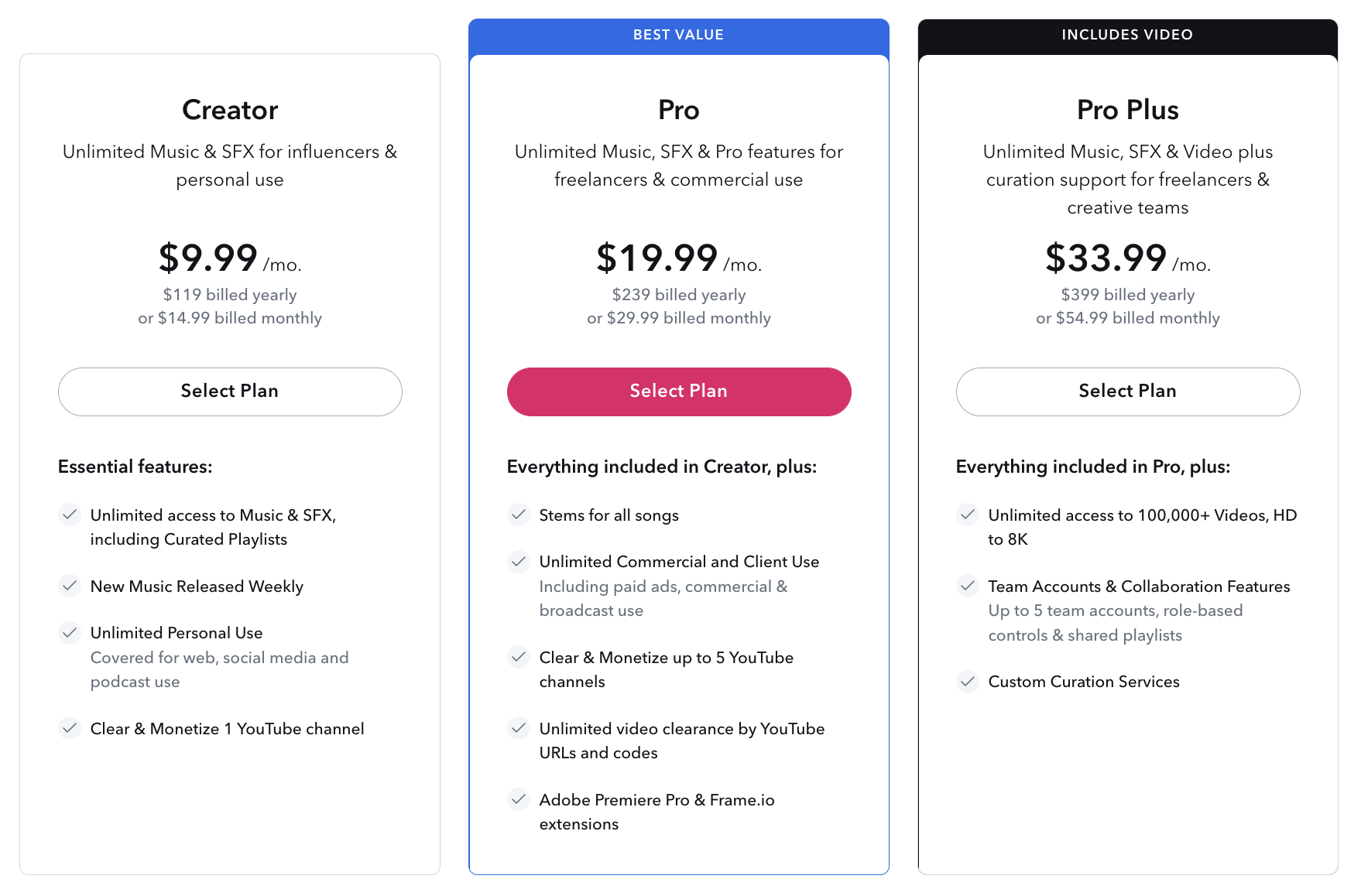
Nov 14, 2019
*Updated March 2022
As a creator, you’ve done your homework. You’ve explored the best music libraries available, and you realized that Artlist and Soundstripe both offer strong subscription plans at affordable prices.
More importantly, you realized that getting a membership with a music licensing company will make your life a lot easier. It cuts down on the amount of time you’ll spend searching for music and protects you from copyright claims when you use songs in your work.
You can safely assume that we’ve done a lot of research about music licensing and all of the options in the market. So let's start this out by saying we have immense respect for every company in this business, and we think each product does different things very well.
You might think Soundstripe and Artlist seem similar in terms of licensing and libraries. But some of the key differences come down to fine-print details that can get a little confusing if you’re new to this sort of thing.
We know you want to get the most out of whatever service you choose. That probably means some combination of great music, affordable pricing, and a licensing agreement that protects you and your projects.
Finding the right music for your videos should be fast, affordable, and easy, so we’re here to give you the tools to make an educated decision.
Is Artlist or Soundstripe better?
Both Soundstripe and Artlist offer plans starting at $9.99/month. And while the Artlist library includes 12,000 songs and Soundstripe offers 7,000 songs, Soundstripe consistently adds 200 new tracks each month (compared to Artlist's 150).
Another important difference is that Soundstripe only uses music produced exclusively for our library. That's not just to create FOMO with award-winning artists — it means we can provide you lifetime licenses without any hassle or confusion.
Other factors that may impact your decision are the library/search experience (how easy it is to the platform) and features/tools to streamline your editing process (like workflow integrations). But we'll get into all of that later.
Outside opinions
Before we get any further, let’s be honest: You’re going to want an outside opinion. We get that. And most times you want to hear from someone you already know and trust.
YouTube is like a watering hole for content creators. You can hear from people that are dealing with challenges and questions similar to what you're going through. It’s also a free catalog of product reviews from filmmakers and vloggers who’ve tested out different royalty free music options and shared their thoughts about them.
Here are some of the most in-depth reviews we found that break down the Artlist vs Soundstripe comparison.
(If you prefer to read a summary instead of watching these videos, we’ve included a detailed synopsis in the next section.)
Matt Johnson is a popular wedding videographer who brings a unique perspective on the music licensing debate. Between running a successful business, managing a YouTube channel, and working on actual projects, it’s no surprise that he has a lot of experience with royalty free music companies.
RYN Photography is — as you can probably guess — a professional photographer, but his YouTube channel has a healthy mix of short films, how-to videos, and vlog entries. This particular video is a high-level look at three of the most popular music licensing options.
The name of the channel says it all, really. The Week I Review is a mix of funny vlogging and product/experience reviews. And as a channel that often uses B-roll footage and background music, this review approaches music licensing from the “bang for your buck” angle. (This was also the most nitty-gritty comparison we found.)
But if that was a little too much information for you, here’s a synopsis about what these creators said on the three big topics you probably care the most about.
Music library content
The obvious difference between royalty free music libraries is the exclusive content on each platform. Artlist has a library of over 12,000 songs, and you’ll get new music added every month. The library focuses on full-length tracks, so you won’t find instrument-specific stem files or sound effects — just a lot of quality songs.
You can also get access to a sound effects library, with 25 different categories. And Artlist also licenses stock video through Artgrid (a sibling site).
It's worth noting that Artlist does have a daily limit of 40 songs or 100 sound effects. That's more than you'll need for most individual projects, but it can be an issue for creators who are working off a project calendar.

Comparatively, Soundstripe offers upwards of 9,000 songs, with around 200 new tracks added each month. And every song include stem audio file options so you can get the exact sound you want.
You can also get access to a library of over 60,000 sound effects and more than 100,000 stock video files. It's like an all-in-one stock media hub for your projects.

But let’s be honest: That’s a lot to sort through. Navigating a song library is something every reviewer discusses because nobody wants to spend hours clicking through a confusing or disorganized mess of track names.
User interface plays a big factor in the overall experience. Soundstripe is designed to help you find the music you want quickly so you can get back to your projects. (Ideally, our goal is to help you find a song in 5 minutes or less.)
You can filter songs via categories like genre, mood, and instrument. And if you have a very clear vision for what you want, you can search for a specific BPM, song duration, or music key.
There's even an option to see songs similar to the one you just listened to. That means you don't even need to worry about searching and filtering — you've got instant access to tracks that you're almost guaranteed to like.
You can also browse through curated playlists if you're not entirely sure what you want for your current project.
Artlist offers similar options, although there aren't as many filters to choose from. You can browse by mood, genre, the theme of your video project, and instrument. Or you can check out playlists in the Spotlight section.
Licensing details
Ah, music licensing. Most reviewers tend to spend most of their videos on this topic, because it’s complex and important. We’ll do our best to keep it short and sweet.
With Artlist, you get unlimited song downloads, but you're limited to 40 downloads per day. That doesn't sound "unlimited," but the key takeaway is that your subscription provides a lifetime license for the songs.
However, there are technicalities about how you can use the music. According to the company's terms of use, Artlist's music is only licensed for video production, which means finding a song for your audio-only projects (like a podcast) can be a bit complicated.
Soundstripe takes a slightly different approach. Your subscription still provides a lifetime license for the songs you download, and you can use any song for either audio or video projects.
Once you're subscribed, licensing a song is as simple as clicking the "Download" button. And once a song is licensed, you'll never have to re-license it again as long as you're a subscriber.
Pricing model
Now let’s address everyone’s biggest question: What’s the price difference?
Both Artlist and Soundstripe use a subscription model so you don't have to worry about paying for individual song licenses (which can get a little pricey).
For a Personal plan, you'll pay Artlist $120 for an entire year ($10/month) or $14.99 if you choose a monthly payment plan. This licensing model covers content you share on social media platforms.
The Unlimited plan covers personal projects as well as commercial projects and costs $200 for an entire year. There's no monthly payment option for this plan, but it covers social media stuff as well as paid ads, podcasts, TV commercials, etc.
Here's a visual breakdown of those pricing tiers:

Soundstripe offers three membership tiers: Creator, Pro, and Pro Plus. And you can choose whether you'd like to pay yearly or monthly, which means more flexibility for your budget and schedule.
If you're curious how each of these plans differ, here's a breakdown:

You can browse the full library at any time, no account necessary. But with a free Soundstripe account you're able to download song previews, create your own song playlists, and favorite the tracks you like most. You can also get access to our workflow integrations that will make adding music to your projects even easier.
Workflow plugins and extensions
Okay, this isn't actually part of the three questions most people have when comparing Artlist vs Soundstripe. But one extra benefit of Soundstripe is that you are able to integrate Soundstripe's music library directly into some of the most popular video creation tools.
You can get the Soundstripe extension for Adobe Premiere Pro, letting you access our library and drop songs into your timeline without having to leave your workflow.
There's also a Frame.io integration, which lets you drop song previews into projects. After all, when you're collaborating with others or getting client approval, being able to swap out pieces of the project can save you a lot of time.
Last but not least is Soundstripe's Twitch extension, which gives streamers an entire library of royalty free music that they can use without worrying about copyright claims and DMCA takedowns.
These three resources are benefits you won't find with other royalty free music platforms, and you'll get access to them with any Soundstripe subscription.
Choosing a music licensing company that works for you
We just threw a lot of information at you, but hopefully we at least answered your questions about which royalty free music subscription will work best for your needs.
And now that you’re a pro on all the differences between Artlist vs Soundstripe, it’s time to make your decision, right?
Not necessarily! If you’d like to check out Soundstripe for yourself, you can browse our music library today — there’s no pressure to commit to anything.
In fact, you can sign up for a free account, which lets you preview songs in your projects and create custom playlists. So you can try Soundstripe for yourself and make sure you’re going with the library that helps you find music quickly, easily, and affordably.
Further reading
Interested in reading more top resources and getting our best filmmaking tips and tricks? Here are a couple of our most popular articles from across the Soundstripe blog: